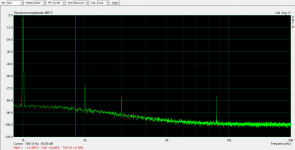CFB seems to heal the micro detail smearing of most PP amplifiers I've always hated, while in SE it fights muddyness at medium to high power levels.
The SSE can use CFB. I find that it does a good job of making cheap OPT's punch above their price point. It also works well with UL on some speaker systems. In both cases it tends to improve the DF and distortion while improving the frequency response by lowering the plate impedance of the output tube.
Care must be used when applying CFB in a push pull amp, especially with budget OPT's. Any imbalance in the OPT will upset the balance of the output stage. This may lead to worse performance at the frequency extremes, and even instability and poor overload recovery.
This one sounded pretty good and would probably perform nearly identically with a 6L6GC as output tube. Of course, it has a couple of fet followers and an active load in there, so the sand might offend some. I got 10W out of it.
Ignore the peak at ~8.7kHz. That is an artifact of the measurement setup. Distortion measurement was at 1W.
Ignore the peak at ~8.7kHz. That is an artifact of the measurement setup. Distortion measurement was at 1W.
Attachments
I find that 10% CFB works in most PP even with lower gm pentodes like the 6F6: triode plate resistance, lower distortion than triode for 2X the output power. For the classic 6F6 pentode class A PP output stage recommended in the datasheet (285V g2, 315V on the plate and self bias into 10K pl-pl) I can get 10W at 1% THD easy with limited voltage drive (102V grid-to-grid) still doable with a simple high gain LTP....for a complete power amp.
With high gm pentodes the effect on distortion and Zout is obviously more profound. I think that 8-12% covers most pentodes. I would not go beyond 15-20% as the voltage drive might become excessive for the practical improvement it offers.
The output transformer with 8-12% feedback can be made rather symmetric but not complicated, with balanced parameters, resulting in nice performance and affordable cost. A typical 8-10K PP for a 10-15W amp can be made reasonably simple and get 70-80KHz bandwidth (-3 dB) without the CFB....
With high gm pentodes the effect on distortion and Zout is obviously more profound. I think that 8-12% covers most pentodes. I would not go beyond 15-20% as the voltage drive might become excessive for the practical improvement it offers.
The output transformer with 8-12% feedback can be made rather symmetric but not complicated, with balanced parameters, resulting in nice performance and affordable cost. A typical 8-10K PP for a 10-15W amp can be made reasonably simple and get 70-80KHz bandwidth (-3 dB) without the CFB....
This one sounded pretty good and would probably perform nearly identically with a 6L6GC as output tube. Of course, it has a couple of fet followers and an active load in there, so the sand might offend some. I got 10W out of it.
Ignore the peak at ~8.7kHz. That is an artifact of the measurement setup. Distortion measurement was at 1W.
I am gonna try your CORONA buffered fb soon....that looks like another killer!😀
Just be aware that built as pictured, DF was >13 so it doesn't have a typical SE tube amp character.
Of course, all you need to do is reduce gain in the first stage if less feedback and more "SE sound" is desired.
Of course, all you need to do is reduce gain in the first stage if less feedback and more "SE sound" is desired.
Just be aware that built as pictured, DF was >13 so it doesn't have a typical SE tube amp character.
Of course, all you need to do is reduce gain in the first stage if less feedback and more "SE sound" is desired.
I have a pair of unused Lundahls LL1627 2.3K/90mA. I was thinking about the EL34 as this transformer matches pretty well the requirements for this tube in SE pentode mode. Or could try with a 18-19W sweep pentode too.

